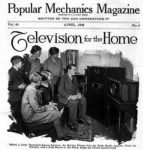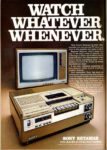The US launches its first space station, Sony releases the Betamax recorder and the first commercial astronaut heads to space… It all happened This Week in Tech History.
This week in 1927 – The Hotel Statler in Boston, MA. became the first hotel to install radio service, allowing its guests to listen to classic radio programs. It was a two-channel system, with the guest selecting a channel on the receiver, then either listening with a headset or the radio’s loudspeaker. It cost the hotel $50,000 to install radios in each of its 1,300 rooms – and another $750,000 to install the service in the chain’s six other hotels.
1928 – Experimental television station W2XB in Schenectady, New York, popularly known as WGY TV after its sister radio station, began the first regular schedule of TV programs. It was a very short schedule. WGY offered programming to the upstate New York audience three times a week for 30 minutes, using the mechanical scanning method. And mechanical scanning was not to be the wave of the future. It was electrical scanning, developed by Philo Farnsworth, that would make television available to the masses.
1973 – Skylab was launched by NASA from Kennedy Space Center. Skylab was the first space station launched by the United States and the only one to be exclusively operated by the US. Skylab included a workshop, a solar observatory, and other systems necessary for crew survival and scientific experiments. Skylab’s re-entry in 1979 was an international media phenomenon with souvenirs for sale that included a bottle of “Skylab Repellant” that came with a money back guarantee if you were to be hit by a piece of debris. The parts of Skylab that didn’t burn up on re-entry landed in mostly unpopulated areas of western Australia. One county fined NASA $400 for littering, which went unpaid until 2009 when it was paid on behalf of NASA with funds raised by a morning radio show.
1975 – Sony introduced the Betamax videocassette recorder. This also spurned the intense videotape format war, with JVC’s Video Home System, or VHS format. This format war was very similar to the Apple/IBM rivalry, as early on, Sony insisted on keeping their technology proprietary and JVC welcomed a more open-source approach where they would license the technology to competitors. VHS ultimately won the format war, and despite this, Betamax production and sales lasted 41 years until Sony finally pulled the plug in March of 2016.
And this week in 2004 – The SpaceShipOne rocket, developed by Scaled Composites in Mojave, California and piloted by Mike Melville, climbed to 211,400 feet, becoming the first privately funded vehicle to reach the edge of space. This flight also made Melville the first Commercial astronaut in history.






